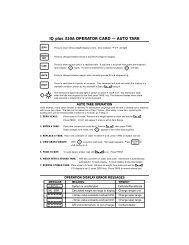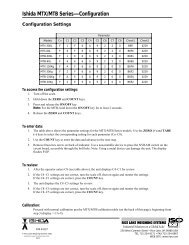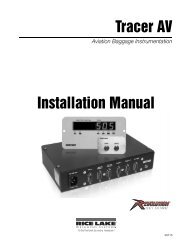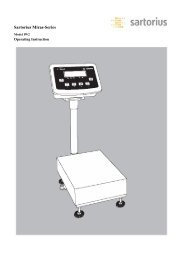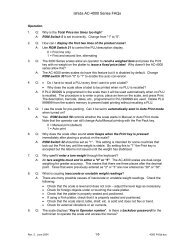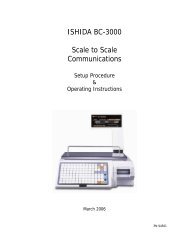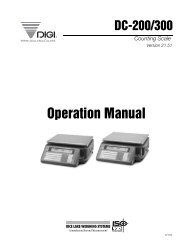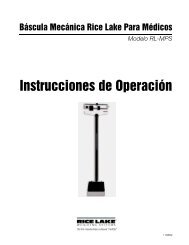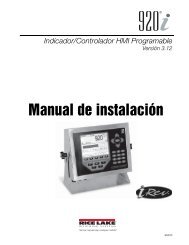920i Installation manual - Rice Lake Weighing Systems
920i Installation manual - Rice Lake Weighing Systems
920i Installation manual - Rice Lake Weighing Systems
Create successful ePaper yourself
Turn your PDF publications into a flip-book with our unique Google optimized e-Paper software.
About This Manual<br />
This <strong>manual</strong> is intended for use by service technicians<br />
responsible for installing and servicing <strong>920i</strong> ® digital<br />
weight indicators. This <strong>manual</strong> applies to Version<br />
5.02.00 of the <strong>920i</strong> indicator software, which is<br />
compatible with both the serial interface and USB<br />
hardware versions of the indicator.<br />
Configuration and calibration of the indicator can be<br />
accomplished using the iRev 4 configuration utility,<br />
serial commands, or the indicator front panel keys.<br />
See Section 3.1 on page 24 for information about<br />
configuration methods.<br />
Some procedures described in this <strong>manual</strong><br />
require work inside the indicator enclosure.<br />
These procedures are to be performed by<br />
qualified service personnel only.<br />
Authorized distributors and their employees<br />
can view or download this <strong>manual</strong> from the<br />
<strong>Rice</strong> <strong>Lake</strong> <strong>Weighing</strong> <strong>Systems</strong> distributor<br />
site at www.ricelake.com/<strong>manual</strong>s.<br />
The Operator Card included with this <strong>manual</strong><br />
provides basic operating instructions for users of the<br />
<strong>920i</strong>. Please leave the Operator Card with the<br />
indicator when installation and configuration are<br />
complete.<br />
1.0 Introduction<br />
The <strong>920i</strong> is a programmable, multi-channel digital<br />
weight indicator/controller. The configuration can be<br />
performed using the front panel, with an attached<br />
USB-type keyboard (or PS/2 keyboard if using serial<br />
interface), or by using the iRev 4 utility.<br />
Custom event-driven programs can be written with the<br />
iRite language up to 512K in program size. These<br />
programs are compiled with an iRite compiler utility,<br />
which can only be downloaded into the indicator. The<br />
RLWS Web Update utility can be used to download<br />
firmware upgrades to a PC from the RLWS web site;<br />
iRev 4 provides functions for installing the new<br />
software into the <strong>920i</strong>.<br />
Onboard Features<br />
NOTE: Choice of interface board (serial or USB) affects Port2.<br />
Features of the <strong>920i</strong> include:<br />
• Support for A/D scale or serial scale inputs.<br />
The maximum number of scale inputs is 28;<br />
these can be combined to represent up to 32<br />
scale configurations.<br />
• Six digital I/O channels on main board, each<br />
configurable as either input or output.<br />
• Four serial ports on main board (Ports 1–4)<br />
support duplex RS-232 up to 115200 bps. Port<br />
2 supports hardware handshaking and remote<br />
keyboard input; Ports 3 and 4 support 20mA<br />
output; Port 4 supports 2-wire RS-485<br />
communications.<br />
• With USB interface card: onboard USB<br />
support for a host PC and the following<br />
devices: one flash drive, two printers, and/or<br />
one keyboard (connecting more than one<br />
device requires a USB hub). The USB<br />
interface card applies only to Port 2.<br />
• With serial interface card: external DB-9 and<br />
DIN-8 connectors for serial connection to a<br />
PC and attachment of PS/2 remote keyboard.<br />
(cannot be used with the USB card).<br />
• Available in 115 VAC and 230 VAC North<br />
American and European versions.<br />
Other features include:<br />
• 62K of non-volatile RAM can be allocated to<br />
databases using the iRev 4 database editor.<br />
• Configurable print formats can be defined for<br />
up to 1000 characters each. These formats are<br />
used to print gross or net weights, truck in/out<br />
weights, setpoint weights, accumulator<br />
weights, alert messages, and header<br />
information. Additional print formats can be<br />
created with iRite.<br />
• Six truck modes to store and recall weights<br />
for gross, tare, and net printing. The truck<br />
register contains fields for ID number, weight,<br />
and the transaction time and date. Weights can<br />
be stored permanently or erased at the end of<br />
the transaction.<br />
• The setpoint engine supports 31 configurable<br />
setpoint kinds. Setpoints can be arranged in a<br />
sequential batch routine of up to 100 steps. If<br />
setpoints are configured as free running<br />
setpoints, they can be tied to program control.<br />
This allows for simultaneous batching<br />
operations to be written with the iRite<br />
language.<br />
The <strong>920i</strong> is NTEP-certified for Classes III and III L at<br />
10,000 divisions. See Section 11.14 on page 135 for<br />
more information about additional certifications and<br />
approvals.<br />
Introduction 1




